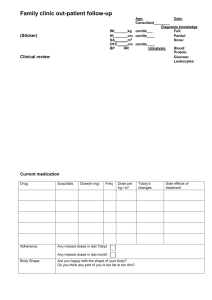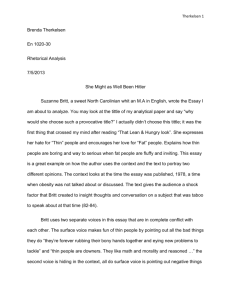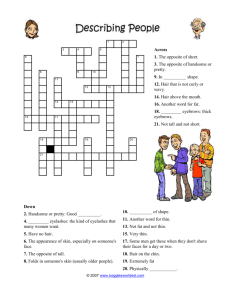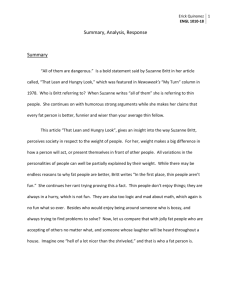File - Amanda Thomas
advertisement
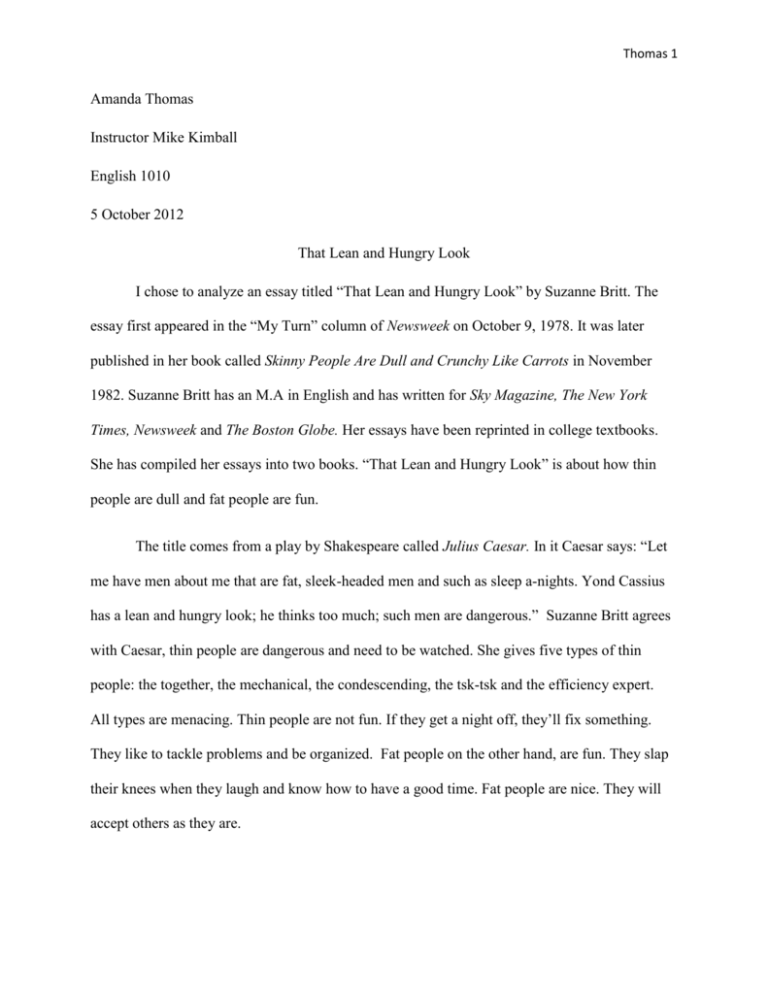
Thomas 1 Amanda Thomas Instructor Mike Kimball English 1010 5 October 2012 That Lean and Hungry Look I chose to analyze an essay titled “That Lean and Hungry Look” by Suzanne Britt. The essay first appeared in the “My Turn” column of Newsweek on October 9, 1978. It was later published in her book called Skinny People Are Dull and Crunchy Like Carrots in November 1982. Suzanne Britt has an M.A in English and has written for Sky Magazine, The New York Times, Newsweek and The Boston Globe. Her essays have been reprinted in college textbooks. She has compiled her essays into two books. “That Lean and Hungry Look” is about how thin people are dull and fat people are fun. The title comes from a play by Shakespeare called Julius Caesar. In it Caesar says: “Let me have men about me that are fat, sleek-headed men and such as sleep a-nights. Yond Cassius has a lean and hungry look; he thinks too much; such men are dangerous.” Suzanne Britt agrees with Caesar, thin people are dangerous and need to be watched. She gives five types of thin people: the together, the mechanical, the condescending, the tsk-tsk and the efficiency expert. All types are menacing. Thin people are not fun. If they get a night off, they’ll fix something. They like to tackle problems and be organized. Fat people on the other hand, are fun. They slap their knees when they laugh and know how to have a good time. Fat people are nice. They will accept others as they are. Thomas 2 The tone of this essay is funny. There is a sentence that says thin people are “crunchy and dull like carrots.” That is an exaggeration not meant to be serious. There is some harsh criticism of thin people in this essay. Suzanne Britt also exaggerates the characteristics of fat people, but not harshly. She is definitely anti-thin. The language used is casual. There are no big or unusual words. It is almost like she is talking to me. I can hear Suzanne Britt’s voice and picture her in my head. I do not know what she really looks like and I’m not sure I want to know. She never actually says outright whether she is thin or fat, but I don’t think she would have such a problem with thin people if she were one. Suzanne Britt was 32 when she wrote this essay and I think that is the audience she was trying to reach. The way she grabs the audience is by talking about friends and hanging out with them. Young people like to get together with friends so by telling those kinds of stories the audience can relate to what the author is saying. More specifically I think she is appealing to overweight thirty year olds. This essay puts fat people in a positive light. Everyone likes to hear how their way of life is the best. The use of humor makes it less likely for thin thirty year olds to take offense. If someone gets mad, it can be argued that the essay is just a joke. Humor also shows that a presumably fat person is funny, which is what the essay is all about. Thirty year olds are wise; they know when someone is being funny and when someone is being serious. Like I said before, this essay was published in 1978. Thirty four years later this essay is still relevant. There will always be thin and fat people, and people in between. According to the CDC in January 2012, 35.7% of American adults were obese or overweight. Since the 1970s obesity has been on the rise. There is a theory as to why this happened. In the 60s, women usually stayed home and cooked the family’s meals. Two hours of a housewife’s day was spent cooking and cleaning up after meals. The 1970s was the tipping point for the obesity epidemic. Thomas 3 As more women entered the workforce, microwave and packaged foods became more popular. They are cheap, tasty and easy to prepare. Single and married men had to fend for themselves. Women spent little or no time on food preparation. The convenient food had more refined carbohydrates, fats and sugars causing people who ate those foods to gain weight. In 1978 when this essay was written, the number of overweight people was getting higher. This made people realize the importance of diet and exercise. A lean body has always been ideal for women, but becoming lean is not easy to do, enter in diet pills. The weight loss trend of the 1970s was diet pills. Some of the pills claimed to stop the body’s absorption of carbs. People could eat all the microwave and fast food they wanted without gaining weight. Turns out, the undigested food was going straight to the colon. These pills were pulled off the market in 1983 after many reports of vomiting and abdominal pain. Diets created by physicians were also popular. The Atkins diet was created in 1972 by Dr. Robert Atkins. It claimed to be a cure for heart disease. This diet was popular again in the early 2000s. Some thin people are mean and some fat people are nice, but not all. I know several very fun, friendly, outgoing thin people. I don’t know exactly what Suzanne Britt means when she says “thin people.” Is it people of average weight and size or an anorexic look? I am a naturally small person and I don’t think I am menacing or dangerous. I know some fat people that could be classified that way. She contradicts herself when she says fat people are nice and accepting of everyone and then is so mean towards thin people. She should have said: fat people will take you in…unless you are a thin person. The examples given are not really fact. The thin people mentioned are just a select few that Suzanne Britt has had interactions with. She could be talking about the same thin person for all I know. She is making a hasty generalization about thin people. Not every thin person is thin because they don’t eat; some are thin because of genetics. Thomas 4 The same goes for the other side. There are plenty of surly, organized, problem-solving fat people. I think the essay was well received. The obesity rates were up and people needed to see how being fat isn’t all that bad. Even though what she says is not always true, I thought the essay was fun and I enjoyed reading it.
